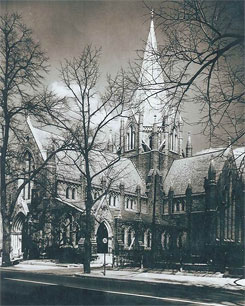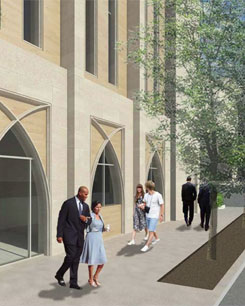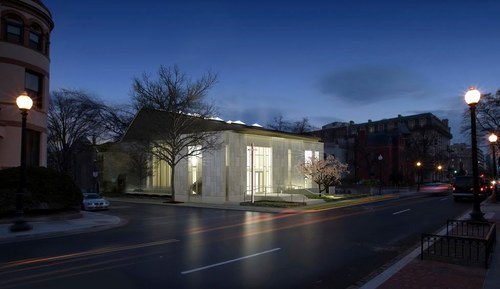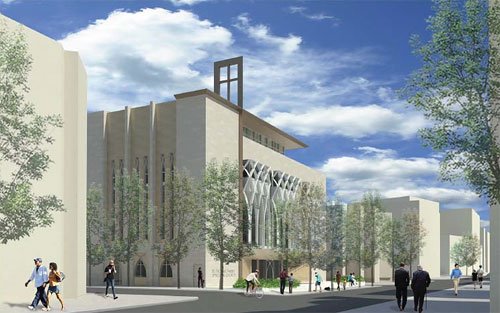Dupont church ruins may become new housing and a new church
In August 1970, an arsonist poured 12 gallons of gasoline on the Gothic 71-
old St. Thomas Parish at 18th and Church streets in Dupont Circle. The building burned in minutes. Soon, only the parish hall, some ruins around the altar, and a single stone gable pointing to the sky remained.
Soon, that spot could become part of a new church and an apartment or condominium building.


Left: The 1899 building. Right: Concept design for a new church. All images from St. Thomas unless otherwise noted.
After the fire, most of the original building became a small park, and in fits and starts, the Episcopal congregation there worked to rebuild. They converted the 1922 parish hall behind the church into worship space and have used it since. But there’s no way for a person in a wheelchair to reach the sanctuary, nor a casket for a funeral. Nor is there enough space for other programs.
From 2007 to 2012, Matthew Jarvis, a young architect and parishioner, designed a new church on the site of the old one. It was a modest, low building compared to the 120-foot-tall original. A roof with 12 triangular skylights would envelope the gable at one end and taper down to a two-story stone façade on 18th Street.
The church looks to private development
But the parish and the diocese, which in the Episcopal Church controls the property, concluded that they couldn’t afford to build and maintain this larger building. After long discussions with church members, they decided that the only way to be able to afford a new building was to partner with a developer, who would construct a residential building on part of the property, raising money for the church.
Working with Michael Foster of MTFA Architecture, the congregation created this draft design. Personally, I find grand religious architecture more compelling than the subdued design of the last attempt. It also better matches the other buildings along 18th Street, most of which are at least 4 stories and some rise as high as 9.
Meanwhile, a 70-foot residential building with 6 or 7 floors would face Church Street. (Disclosure: I live on this block, and can see the church from my window.) After receiving proposals from several developers, the congregation chose CAS Riegler, a firm based in Shaw, to design the residential building as well as to develop two vacant townhouse lots on P Street the church now uses for parking.
Some decisions are open for discussion, some are not
At a community meeting Wednesday night, church officials, Foster, and Kevin Riegler from CAS Riegler, emphasized that the process was still very young. Unfortunately, the meeting started out somewhat disorganized. A planned slide presentation about the church’s overall plan for the site didn’t materialize because of technical difficulties.
Some residents felt “surprised” that the church had already made a number of decisions with MTFA in writing their request for proposals: they will place the religious building on the 18th Street side of the property and the main residential building on Church Street; they want to demolish most of the parish hall; and there will be 15 parking spaces for the church and 41 for the residential building.
Foster never came right out and revealed these facts, which only came up because some residents had gotten a look at the RFP. It took a few questions from residents to clarify that Riegler was only responsible for the residential building and that the church’s plan was largely not open for discussion.
Riegler emphasized his firm had only come on board 11 days prior and the residential building was “a blank slate.” While he was laudably bringing in community members now in an effort to get input on the ground floor, many decisions about the site had already been settled before he was involved.
Residents worry about density and losing the park
“You’ve grieved for the loss of your church for 40 years,” said one resident at the often-acrimonious meeting. “Now we have to grieve for the loss of our park.” The park will no longer be public open space, though Riegler noted that with Dupont Circle one block west, there is already a good amount of space, and he didn’t even mention Stead Park one block to the east.
Others, including some who had supported the church’s earlier plan to build on the park, felt the building was too tall. Riegler pointed out that a 70 foot building, which is what zoning allows, is shorter than the 90-foot-tall building at 18th and P (or Massachusetts) which until recently housed the National Trust for Historic Preservation, or the also 90-foot apartment buildings on the corner of 17th and Church, at the opposite end of the block.
I personally would like to see the site accommodate as much new housing as possible, given that DC desperately needs to build 41,000 to 105,000 new homes over 20 years in order to house all of the people, at all of the income levels, who want to move to or stay in the District. But to many, the idea of what could be 58 new housing units represents a big change.
A number of residents argued that the church is not fulfilling its godly mission by partnering with a developer in a transaction that was mostly about dollars. “Is it the church’s mission to build 58 condos? That’s a paltry mission,” one resident said. “We don’t need more apartments, we don’t need more autos,” said another who had just moved to Dupont Circle when the church burned in 1970.
Yet another nearby resident asked why the congregation had to stay on the site at all. “Why don’t you guys move? Find another facility” and donate the land to a different nonprofit, she suggested. ANC Commission Leo Dwyer argued that the church has been a treasured neighbor, letting a local LGBT congregation meet there and hosting health groups, not to mention serving as a polling place (at least for now; the DC Board of Elections plans to move and consolidate polling places).
Still, over the course of the meeting many people (including myself to some degree) grew a little more comfortable with some details that had been worrisome. Maybe some of these resemble the stages of grief: denial, anger, bargaining, depression, acceptance. The conversation starts with claims that the community wasn’t involved, then moves to arguments that a building is too intrusive, and works its way to a discussion about what neighbors can constructively get in the design to maximize their quality of life within the constraints of zoning, property rights, and fairness.
What will be preserved?
A lot of questions remain. Chief among them is what will happen to the stone façade of the parish hall, which certainly merits historic preservation, and the gable and ruins, which do so even more. While the new design for a church on 18th Street is impressive, it might have been easier to preserve more of the old church by building the new church where the old church elements are instead of on the other end of the property.
I asked Ryan Winfield, chair of the church’s Building Committee, who said they didn’t want the church to be hidden away behind other buildings. It once had a grand entrance on 18th Street, and they’d like it to again, he said. A lot of people don’t even know it’s there now, and assume it’s just a completely abandoned site. Plus, they’d like to make reference to the past but also move beyond it after spending 40 years literally in its shadow.
Still, there are countervailing forces between a congregation that wants to design the best site from their point of view, neighbors who might prefer the slightly lower church to be adjacent to their homes, and preservation laws that give historic architectural elements, as this most certainly is, a special legal status.
Riegler promised another meeting in a few weeks to present their early designs for the residential buildings. He and his architectural partner for the residential building, Hickok Cole, will have to find a way to design something that preserves, incorporates, and references old elements while also being very much new.
Ultimately, the church has the right to build on their vacant property, and as long as it’s “historically compatible,” Riegler has the right to build a 70-foot residential building. For residents who don’t want any building here, in particular, this process may require moving through the grieving process to accept that the park will go away, and then working to push for the most attractive design possible.



